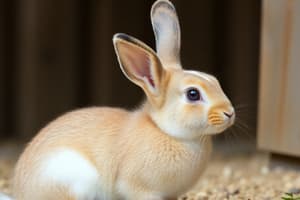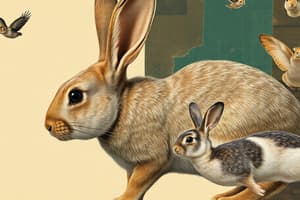Podcast
Questions and Answers
What is the primary purpose of a breeding record in a rabbitry?
What is the primary purpose of a breeding record in a rabbitry?
- To evaluate the productivity of does and bucks (correct)
- To record the dates of shows entered
- To maintain a count of rabbits in the rabbitry
- To track the sales of rabbits
Where should the tattoo be placed in the rabbit's ear?
Where should the tattoo be placed in the rabbit's ear?
- Above the main visible vein in the ear (correct)
- Below the main visible vein in the ear
- On the back of the ear
- On the tip of the ear
What is the primary goal of rabbit breeding for meat production?
What is the primary goal of rabbit breeding for meat production?
- To raise rabbits for their wool
- To raise rabbits for human consumption (correct)
- To produce high-quality breeding stock
- To raise rabbits for their fur
What should you do if the rabbit's ear is dirty?
What should you do if the rabbit's ear is dirty?
Which breed of rabbit is commonly raised for its wool?
Which breed of rabbit is commonly raised for its wool?
What should you do to the tattoo pliers before applying the tattoo?
What should you do to the tattoo pliers before applying the tattoo?
What is an important consideration when raising rabbits for wool production?
What is an important consideration when raising rabbits for wool production?
What should you do after applying the tattoo?
What should you do after applying the tattoo?
Why is it important to keep good records in a rabbitry?
Why is it important to keep good records in a rabbitry?
What should you do if the rabbit's ear is very hot?
What should you do if the rabbit's ear is very hot?
What is the normal temperature range for a rabbit?
What is the normal temperature range for a rabbit?
What is the main function of the cecum in monogastric animals like rabbits?
What is the main function of the cecum in monogastric animals like rabbits?
Which of the following is a sign of a sick rabbit?
Which of the following is a sign of a sick rabbit?
What is the purpose of a pedigree record in rabbit breeding?
What is the purpose of a pedigree record in rabbit breeding?
What is a common nutrient found in all feeds?
What is a common nutrient found in all feeds?
Why should the ear be cleaned and dried before applying a tattoo?
Why should the ear be cleaned and dried before applying a tattoo?
What should be done if the rabbit's ear is very hot during the tattoo process?
What should be done if the rabbit's ear is very hot during the tattoo process?
What should be done to the tattoo pliers after they are properly positioned in the ear?
What should be done to the tattoo pliers after they are properly positioned in the ear?
What should be done after applying the tattoo?
What should be done after applying the tattoo?
Why is it important to completely penetrate the ear with the tattoo digits in young rabbits?
Why is it important to completely penetrate the ear with the tattoo digits in young rabbits?
Why is it important to place the tattoo above the main visible vein in the rabbit's ear?
Why is it important to place the tattoo above the main visible vein in the rabbit's ear?
What should you do if the rabbit's ear is very hot during the tattoo process?
What should you do if the rabbit's ear is very hot during the tattoo process?
Why is it better to completely penetrate the ear with the tattoo digits in young rabbits?
Why is it better to completely penetrate the ear with the tattoo digits in young rabbits?
What should you do after applying the tattoo?
What should you do after applying the tattoo?
Why is it important to hold the ear straight when applying the tattoo?
Why is it important to hold the ear straight when applying the tattoo?
Flashcards are hidden until you start studying
Study Notes
Rabbit Records
- Herd Record: a record of every rabbit in the rabbitry, including sire, dam, sex, color, date of birth, and date of departure
- Breeding Record: a record of each breeding to track productivity and breeding quality
- Show Record: a record of show entries, classes, and awards received to track a rabbit's strengths and weaknesses
Uses of Rabbits
- Breeding Stock: rabbits raised for high-quality offspring, requiring good records and quality control
- Meat Production: rabbits raised for meat
- Fur: rabbits raised for fur to be used in novelty, craft, and consumer products
- Wool: rabbits raised for wool, such as Angora rabbits, requiring clean, durable, and easily processed wool
- Pets: rabbits raised for companionship
Meat Cuts
- [Image of meat cuts diagram]
Body Type
- [No additional information provided]
Tattooing a Rabbit
- Select and prepare tattoo digits
- Place the rabbit in the proper tattooing position
- Hold the rabbit securely and tattoo the digits correctly in the left ear
Health
- Temperature: 100-104°F
- Heart rate: 150-300 beats per minute
- Respiratory rate: 30-60 breaths per minute
Nutrition
- Six basic nutrients: protein, carbohydrates, lipids, minerals, vitamins, and water
- Protein, carbohydrates, fats, minerals, vitamins, and water are essential for rabbit nutrition
Digestive Systems
- Simple tube extending from mouth to anus with associated organs
- Types of digestive systems: ruminant, non-ruminant, and single stomach
- Rabbits have a single stomach and are unable to digest large quantities of fiber without an enlarged cecum
Signs of a Sick Rabbit
- Decreased appetite
- Lethargy
- Hair loss
- Runny eyes
- Discharge from nose
- Diarrhea
- Sneezing
- Fever
- Changes in breathing
Types of Rabbit Records
- Pedigree Record: a family tree of each individual rabbit, listing sires, dams, grand sires, and grand dams, including color and senior weight
Health
- Normal body temperature: 100-104 degrees Fahrenheit
- Normal heart rate: 150-300 beats per minute
- Normal respiratory rate: 30-60 breaths per minute
Nutrition
- Six basic nutrients: protein, carbohydrates, lipids, minerals, vitamins, and water
- Importance of each nutrient in a rabbit's diet
Digestive Systems
- Simple tube extending from mouth to anus with associated organs
- Types of digestive systems: ruminant or non-ruminant, single stomach
- Importance of cecum in non-ruminant digestive systems
Signs of a Sick Rabbit
- Decreased appetite
- Lethargic behavior
- Hair loss
- Runny eyes
- Discharge from nose
- Diarrhea
- Sneezing
- Fever
- Changes in breathing
Types of Rabbit Records
- Pedigree Record: family tree, sire, dam, grand sires, dams, color, and senior weight
- Herd Record: list of rabbits in the rabbitry, sire, dam, sex, color, and date of birth
- Breeding Record: records of breeding, helps decide which does are most productive and which bucks are best
- Show Record: dates and places of shows, classes, and awards received
Uses of Rabbits
- Breeding Stock: raising high-quality offspring
- Meat Production: raising rabbits for meat
- Fur: raising rabbits for fur
- Wool: raising rabbits for wool
- Pets: raising rabbits for companionship
Meat Cuts
- Various cuts of meat from rabbits
Body Type
- Importance of body type in rabbit breeding
Tattooing a Rabbit
- Steps to tattooing a rabbit:
- Select and prepare tattoo digits
- Position the rabbit correctly
- Examine the ear for tattoo placement
- Clean and dry the ear
- Apply the tattoo
- Rub ink into puncture holes
- Apply petroleum jelly over the tattoo
Rabbit Record Keeping
- Herd record: keeps track of every rabbit in the rabbitry, including sire, dam, sex, color, date of birth, and date of departure
- Breeding record: records each breeding to track doe productivity and buck quality
- Show record: tracks show entries, classes, and awards to identify rabbit strengths and weaknesses
Uses of Rabbits
- Breeding stock: high-quality rabbits for breeding, requiring good records and regular shows
- Meat production: rabbits raised for food
- Fur: rabbits raised for fur used in novelty, craft, and consumer products
- Wool: rabbits raised for wool, with Angora breed being a notable example
- Pets: rabbits raised for companionship
Meat Cuts
- No specific information provided
Body Type
- No specific information provided
Tattooing a Rabbit
- Select and test tattoo digits
- Place rabbit in proper position with head and rump held
- Ensure digits are correctly aligned and tattoo is legible
- Clean and cool ears before tattooing
- Apply firm pressure for 1-2 seconds to ensure needle penetration
- Rub ink into puncture holes and apply petroleum jelly over the tattoo
Health
- Normal temperature: 100-104°F
- Normal heart rate: 150-300 beats per minute
- Normal respiratory rate: 30-60 breaths per minute
Nutrition
- Six basic nutrients: protein, carbohydrates, lipids, minerals, vitamins, and water
- Importance of each nutrient not specified
Digestive Systems
- Simple tube from mouth to anus with associated organs
- Types of digestive systems: herbivores, carnivores, omnivores, ruminant, and non-ruminant
- Single stomach: food mixed with digestive juices
- Cecum: blind pouch in large intestine for fiber digestion
Signs of a Sick Rabbit
- Decreased appetite
- Lethargy
- Hair loss
- Runny eyes
- Discharge from nose
- Diarrhea
- Sneezing
- Fever
- Changes in breathing
Types of Rabbit Records
- Pedigree record: family tree of each rabbit, including sires, dams, and grand sires and dams
Studying That Suits You
Use AI to generate personalized quizzes and flashcards to suit your learning preferences.




